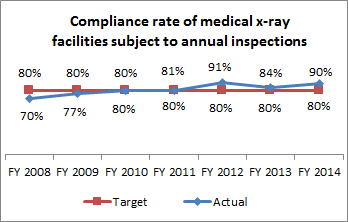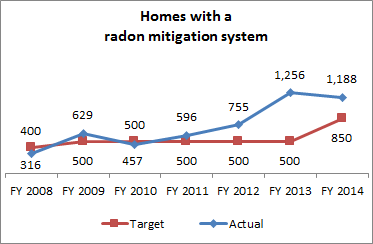The mission of the Division of Radiation Control program is to protect the general public and occupationally exposed employees from sources of radiation that constitute a health hazard.
During the 2015 General Session, the Legislature appropriated for Fiscal Year 2016, $0 from all sources for Radiation Control. This is a 100 percent reduction from Fiscal Year 2015 revised estimated amounts from all sources. The total includes $0 from the General/Education Funds, a reduction of 100 percent from revised Fiscal Year 2015 estimates.
In addition to statewide compensation and internal service fund cost increases, the following appropriation adjustments were made during the 2015 General Session:
X-ray Facilities Compliance
The division performs on-site inspections regarding radiation safety in the use and performance of x-ray units. The division ensures and maintains radiation safety to workers, patients, and the public. This measure shows the compliance rate of medical x-ray facilities subject to annual inspections.

Homes with Radon Mitigation System
The division measures the number of homes where indoor radon problems are mitigated. The goal is to get as many homeowners as possible to test for the presence of radon, a known carcinogen, and then mitigate the home if levels are high.

Radioactive Materials Transportation Inspections
The division inspects incoming waste shipments regarding Class 7 Radioactive material transportation requirements at the EnergySolutions Clive facility. The graph below measures the number of shipments that arrive to the facility versus how many are inspected by staff (based on DOT requirements for the safe transportation of radioactive waste).

Other Radiation Control Performance Measures
In addition to the key performance measures listed above, the division reported the following performances measures for FY 2014:
- regulated over 200 licensed users of radioactive materials;
- registered over 8,500 X-ray tubes and inspected 3,221 X-ray tubes used by hospitals, chiropractors, veterinarians, dentists, and industrial and institutional users;
- regulated the disposal of approximately 57,500 cubic yards of low-level radioactive waste;
- conducted 1,701 radioactive waste transportation inspections of the 2,350 total shipments received at Clive; and,
- tracked nearly 2,800 short and long-term indoor radon tests and over 950 mitigations for indoor radon through the State Indoor Radon Program and in concert with many public and private partners and stakeholders.
In order to accomplish this mission, the Division of Radiation Control is responsible for the following:
- regulating the use and compliance of radioactive materials users;
- regulating X-ray machine registrants and performing inspections;
- maintaining an environmental radioactivity monitoring station as part of a nationwide network;
- protecting the public from ionizing radiation;
- monitoring transportation of radioactive waste;
- regulating uranium recovery facilities and mill tailings;
- regulating low-level radioactive waste management at the EnergySolutions waste disposal facility;
- informing and educating the public regarding the health risks associated with exposure to indoor radon gas by partnering with a broad spectrum of key stakeholders;
- providing information for indoor radon mitigation measures as well as serving as the central data repository of indoor radon test results throughout the State; and,
- regulating groundwater quality permitting and compliance at uranium mills and radioactive waste disposal facilities.
The division enforces rules that limit the amounts of radiation exposure received by the general public and occupationally exposed employees from sources of ionizing radiation. This is accomplished by licensing/permitting and compliance programs within the division. The division conducts routine inspections of: radioactive material users, medical and commercial users of X-ray generating machinery, low-level radioactive waste management facility, and uranium recovery and milling operations.
As an agreement state with the Nuclear Regulatory Commission (NRC), the NRC performs, at least every four years, a comprehensive evaluation of the division's administration of radiation control programs. This performance evaluation includes the radioactive materials licensing and inspection program, the uranium recovery and mill tailings regulatory program, and the low-level radioactive waste management program. During the most recent program evaluation by the NRC, the division received the highest rating of Adequate to protect public health and safety and Compatible with NRC's regulations. The next comprehensive program evaluation will be performed in 2015.
The Division of Radiation Control is divided into the following sections:
Radioactive Materials and X-Ray
The Radioactive Materials section licenses and performs compliance inspections at radioactive material users throughout the state of Utah. The X-Ray section registers and inspects X-ray machinery in medical and commercial facilities to ensure proper use and operation of such radiation-generating machines.
Low-level Waste and Uranium Mills Licensing and Permitting
This section performs all licensing and permitting of commercial radioactive waste disposal facilities and uranium recovery and milling facilities; for example, the EnergySolutions Clive facility in Tooele County, the Energy Fuels Resources (formally Denison Mines), White Mesa Mill in San Juan County, and two other uranium recovery mills that are not operational.
Low-level Waste and Uranium Mills Compliance and Enforcement
This section performs all compliance monitoring and regulatory enforcement of uranium recovery and milling operations and low-level radioactive waste management and disposal.
COBI contains unaudited data as presented to the Legislature by state agencies at the time of publication. For audited financial data see the State of Utah's Comprehensive Annual Financial Reports.